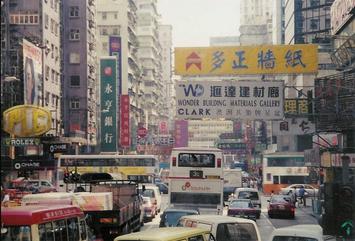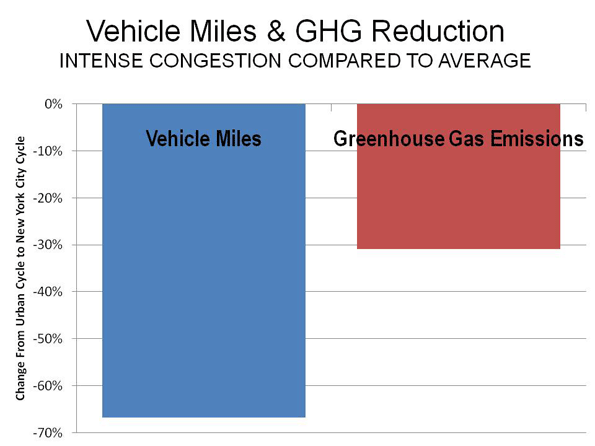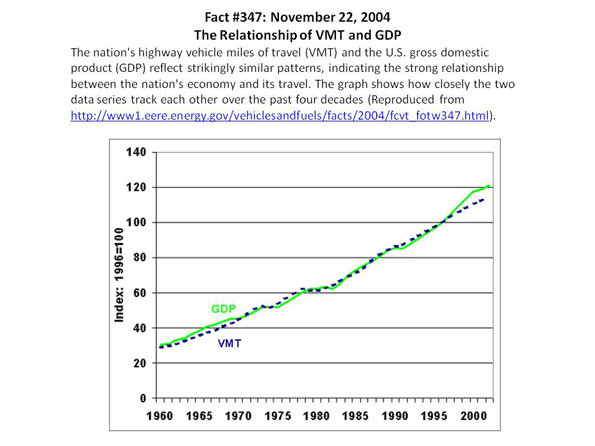
Senators Jay Rockefeller (D-West Virginia) and Frank Lautenberg (D-New Jersey) have introduced legislation that would require annual per capita reductions in driving each year. Another bill, the National Transportation Objectives Act, introduced by Representative Rush Holt (D-Indiana), Representative Russ Carnahan (D-Missouri) and Representative Jay Inslee (D-Washington.) would require a 16 percent reduction in driving in 20 years.
Last week, a highly publicized report by the Urban Land Institute (Moving Cooler) also called for policies that would reduce the vehicle miles traveled (VMT) by people in their cars. This report was analyzed here by Alan Pisarski). The reductions in driving would be achieved by highly intrusive land use policies that would make it impossible for most Americans to live where they want, allow for only minor expansion of roadway capacity and force almost all new development to be within existing urban footprints. It would employ such radical strategies as forcing people to pay $400 per year to park their cars in front of their own homes.
The assumption behind these initiatives is that reducing driving will produce substantial reductions in greenhouse gas emissions. It sounds like a simple enough proposition, since cars emit greenhouse gases in direct proportion to the gasoline they consume. It would seem logical that reducing their use would lower their emissions by a similar percentage. Moving Cooler assumes that for every 10 percent reduction in driving miles, there will be a 9 percent reduction in greenhouse gas emissions.
Meager GHG Emission Reductions from Reducing Driving: But things are not nearly so simple. It appears that reducing vehicle miles would not produce a similar reduction in greenhouse gases from cars.
It is well known that at the slower speeds of vehicle operation in cities, fuel economy tends to decline with speed. Further, as congestion increases, so does fuel consumption, due to longer idling periods (such as at signals or in stopped traffic), more acceleration and more deceleration. Thus, not only does fuel economy drop when average speeds drop, but it drops even further when traffic congestion intensifies. The extent to which any reduction in urban driving would reduce greenhouse gas emissions is not at all well known, simply because there has been insufficient research on the subject.
Perhaps the best indication is a comparison of Environmental Protection Agency (EPA) “driving cycles,” which are tests used to estimate some emissions (although not greenhouse gases) and fuel economy. There is considerable data for the normal urban cycle, which replicates driving conditions in most of the nation’s urban areas. There is much less information available for the “New York City Cycle,” which replicates the congested traffic conditions in New York City, which is far more congested than any of the nation’s urban areas (Note).
Under the New York City Cycle average speeds are two-thirds less than under the average urban cycle. This reduction in speed and increase in congestion results in a 50 percent loss in fuel economy, according to an Argonne National Laboratory Study. Thus, between New York City and the average urban area, fuel efficiency drops at a rate 80 percent of the lower driving rate in New York City.
On average, vehicle travel in New York City is approximately 8 miles per capita daily. In the average large urban area outside New York City (such as the Phoenix urban area, or for that matter the suburbs of New York City), vehicle travel is approximately 24 miles per day per capita. Thus, per capita driving in New York City is 67 percent less than in Phoenix. However, because of the loss in fuel consumption, the greenhouse gas emissions from cars per capita is only 31 percent less (Figure 1). Thus, the limited data indicates that nearly one-half of the greenhouse gas emissions difference between New York City driving rates and Phoenix driving rates are cancelled out by the impacts of slower speeds and increased congestion.

Shortcomings of Policies to Reduce Driving: UCLA’s Lewis Center for Regional Policy Studies Program on Local Government Climate Action Policies raised concerns about relying on VMT reduction policies in a submittal to the California Air Resources Board:
Especially in congested areas of California, VMT is an inadequate proxy for vehicle greenhouse gas emissions.
Yet it is precisely more intense traffic congestion that we can expect if federal laws and policies should force most development into present urban footprints. Between 2010 and 2030, nearly 70,000,000 residents will be added to US urban areas, an increase of more than 25 percent. This increase would mean that the legislation introduced by Congressmen Hold, Carnahan and Inslee would require a one-third reduction in per capita driving to achieve its overall 16 percent reduction. Per capita driving declines such as those envisioned by the Congressmen or Moving Cooler have never occurred before in any American (or international) urban area. By comparison, charging people $400 to park their cars in front of their houses seems utterly reasonable.
Further, higher population densities are associated with more intense traffic, both at the national and international level. Policies such as recommended by Moving Cooler would produce little additional highway capacity to handle the far higher levels of driving produced by a larger population. We could expect traffic congestion to increase markedly. It would take longer to get to work and local air pollution would be more intense (a health impact largely ignored by proponents of higher densities).
The Economic Cost: A serious economic toll would be produced by more grid-locked urban areas, because of the positive relationship between personal mobility and economic performance. Remy Prud’homme and Chang-Woon Lee of the University of Paris have shown that greater economic mobility is associated with greater economic growth. Greater personal mobility also alleviates poverty, according to a Progressive Policy Institute study):
In most cases, the shortest distance between a poor person and a job is along a line driven in a car. Prosperity in America has always been strongly related to mobility and poor people work hard for access to opportunities. For both the rural and inner-city poor, access means being able to reach the prosperous suburbs of our booming metropolitan economies, and mobility means having the private automobile necessary for the trip. The most important response to the policy challenge of job access for those leaving welfare is the continued and expanded use of cars by low-income workers.
The UCLA submission further notes that policies aimed at reducing driving could damage the economy:
… policies which seek to reduce VMT may hinder economic growth without reducing emissions.
The relationship between greater mobility and economic prosperity is also demonstrated at the national level. This is vividly illustrated in the chart from the United States Department of Energy (Figure 2).

The significant improvements in fuel economy from higher mileage cars and less carbon intensive fuels will do far more to reduce greenhouse gas emissions from cars than the meager results that can be achieved by heavy handed policies to “coerce” people out of their cars (as Secretary of Transportation Ray LaHood put it). And, critically, it would do so with far less impact on both economic and physical mobility.
Both the Economy and Greenhouse Gas Emissions at Stake: With the economic challenges facing the nation, policy makers need to steer clear of strategies that hobble the economy, like forcing people to drive less (or pay $400 to park in front of their houses) and make only minor improvements in reducing emissions. Indeed, a society with less money will have less to spend on reducing emissions through the adoption of new technologies that offer greater hope for creating a more prosperous as well as more environmentally sustainable society.
Note: The New York City refers to the City of New York, not the metropolitan area or the urban area.
Wendell Cox is a Visiting Professor, Conservatoire National des Arts et Metiers, Paris. He was born in Los Angeles and was appointed to three terms on the Los Angeles County Transportation Commission by Mayor Tom Bradley. He is the author of “War on the Dream: How Anti-Sprawl Policy Threatens the Quality of Life.”













Compare the Whole System
Who cares what a car's CO2 output is in NYC during gridlock? Per capita CO2e (carbon dioxide equivalent) emissions for a New York resident are 7.1 metric tons, compared to the US average of 24.5 CO2e metric tons per capita. Quite a difference.
http://www.nyc.gov/html/om/pdf/ccp_report041007.pdf
The issue with greenhouse gas "reports" that you conduct is that you address one issue alone. For instance, who cares if there is a "carbon neutral" home? How is that home functioning in an economy, and what is its place in the built environment?
VMT and GDP correlation? What comes first GDP increase or VMT increase? This is a silly statistic. It assumes a high VMT equals a high and ever increasing GDP.
VMT per capita of a NYC resident is quite low compared to most if not all cities in the US, but GDP per capita of a NYC resident is one of the highest in the world. A higher VMT per resident does not equate to a higher income necessarily.
Sure, as economies increase people travel more miles - not to mention technologies increase which allow for better MPG standards which allow for less fuel costs meaning more miles - but that "correlation" is quite misleading especially the way you are expressing it to people.
good points
It's absurd to suggest that more driving equates to more wealth. There is certainly a historical correlation between vehicle ownership and usage and wealth, but that doesn't mean there's a causal relationship between the two. It just proves that developed countries had a love affair with the car in the 20th century.
Vehicle ownership in NYC has been stable or declining for at least 10 years (see http://www.nydmv.state.ny.us/stats-arc.htm), a time period in which both the City's economy and population have grown enormously. That would seem to disprove the notion that decreasing VMT per capita will harm economic growth.
I imagine there are other urban areas outside of the US with a similar experience.
Let Me Clarify
I understand Cox's argument about VMT and economic output, there is indeed a slight correlation at least in regards to our current transportation framework - though he is representing this correlation through a misleading lens. Assuming the only mode of transportation was by walking, of course foot miles (made up statistic, obviously) would increase as economies get stronger. Though, that doesn't mean that economic growth is contingent on people walking more.
Even the stats you posted may show a decrease in cars owned, but an increase in VMT per capita for NY. VMT or transit passenger miles, etc. will always be higher as economies ratchet upwards.
When times are good people have more income to travel places.
My point was that traveling more and longer does not always mean a higher economic output. That ratio is quite low for miles traveled / income for a NYC resident, but someone in a less dense city may be traveling quite a bit mile wise more but earning quite a bit less in comparison. Correlation in that regard is not discernible.
This is very nice post
Thanks for it, i have been seeking for information regarding this material for ages and yours is that the best I even have discovered up to now.
clinical laboratory research microsope
Pointing Out Some Faulty Assumptions
Mr. Cox, you are forgetting an important component – public transportation. You assume that higher density will lead to greater traffic congestion, which will cause greater emissions. Yet a major purpose of higher density is to make public transit more accessible to citizens, which will reduce emissions. It is too expensive to build light rail out to the suburbs (or sufficiently fill buses from the suburbs), so people are stuck with only one option – the private automobile. But in high-density areas, cost-effective public transit systems are possible. In addition, people in high density environments have the option of walking or bicycling to nearby destinations. Therefore, fewer cars will be on the road because fewer people will need them. This will reduce traffic congestion, and thereby reduce greenhouse gas emissions.
As for your section titled "The Economic Cost," you make another faulty assumption. First, you assume that high-density urban areas will be "gridlocked" with traffic. As stated above, that is not true. Secondly, you state that "[g]reater personal mobility alleviates poverty. . . .," but then rely on your faulty "gridlocked" assumption to further assume that high-density areas reduce personal mobility. In actuality, it is our current auto-centric land use policies that reduce personal mobility, thereby reducing economic success. It is estimated that a private automobile costs the average American approximately $5,000 per year. Yet Americans are forced to own automobiles to access spread out destinations. Building high density communities reduces the need for multi-car families, thereby saving money. At the same time, personal mobility in high-density areas is not reduced (more likely, it is improved) because there are other viable transportation options (e.g. walking, bicycling, buses, light rail, ride-sharing). Therefore, high-density areas actually increase personal mobility, and should therefore increase economic success.
This is very nice post
I want to it articles thank for your time of this nice read!!! I definitely enjoy every little bit of it and I have you bookmarked to check out new stuff on your blog a must read blog!!!!
Deep freezer ,Circulating Water Bath
totally wrong
The Argonne report defines the "New York City Cycle" as a stop-and-go traffic pattern with speeds averaging 7 mph. It is not supposed to be a model of the average traffic pattern at all times of day in all parts of New York. Traffic is certainly like that in Midtown at rush hour, but you are completely wrong to assume that all driving in all five boroughs in New York occurs those conditions. So your argument that greenhouse gas emissions per vehicle mile traveled are much higher in urban areas is based on a fallacious premise.